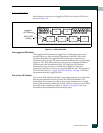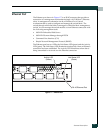
Planning
2-5
Performance
Bandwidth
Bandwidth is a measure of the volume of data that can be transmitted at a
given transmission rate. A Fibre Channel port can transmit or receive at
nominal rates of 1-Gbps, 2-Gbps, or 4-Gbps depending on the device to
which it is connected. This corresponds to actual bandwidth values of
106 MB, 212 MB, and 425 MB respectively. Multiple source ports can transmit
to the same destination port if the destination bandwidth is greater than or
equal to the combined source bandwidth. For example, two 1-Gbps source
ports can transmit to one 2-Gbps destination port. Similarly, one source port
can feed multiple destination ports if the combined destination bandwidth is
greater than or equal to the source bandwidth.
In multiple chassis fabrics, each link between chassis contributes 106, 212, or
425 MB of bandwidth between those chassis depending on the speed of the
link. When additional bandwidth is needed between devices, increase the
number of links between the connecting switches. The switch module
guarantees in-order-delivery with any number of links between chassis.
Latency
Latency is a measure of how fast a frame travels from one port to another. The
factors that affect latency include transmission rate and the
source/destination port relationship as shown in Table 2-2.
Table 2-2. Port-to-Port Latency
Destination Rate
Source Rate
Gbps 1 2 4
1
< 0.6 µsec
< 0.8 µsec
1
1
Based on minimum frame size of 36 bytes. Latency increases for larger frame sizes.
< 0.8 µsec
1
2
< 0.5 µsec < 0.4 µsec
< 0.4 µsec
1
4
< 0.4 µsec < 0.3 µsec < 0.3 µsec


















